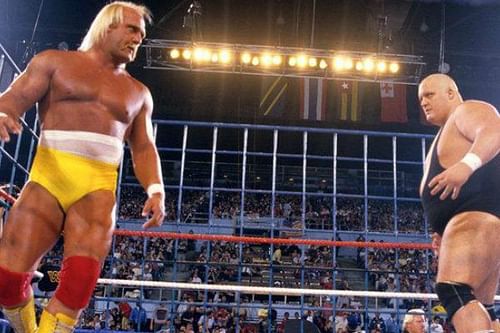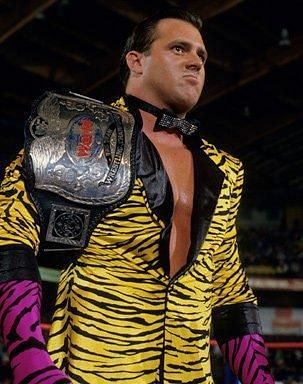
Gimmick Some (Wrestlemania) Lovin': The Blue Bars of Doom

In each edition of Gimmick Some Lovin', we take a look at one iteration of a gimmick match available on the WWE Network. Some are iconic for their success, others for the extent to which they flopped, and some just... happened.
We defined a "gimmick match" as, in any way, adding a rule/stipulation to or removing a rule from a match, changing the physical environment of a match, changing the conditions which define a "win", or in any way moving past the simple requirement of two men/women/teams whose contest must end via a single pinfall, submission, count out, or disqualification.
It's inevitable that a Wrestlemania retrospective would, at some point, have to focus on the controversial Great Orange One (not that one; we won't be talking about Wrestlemania 23 today).
After main-eventing the event's first offering in 1985 in a tag team match, Hulk Hogan defended the World Wrestling Federation Championship against King Kong Bundy in a steel cage as part of Wrestlemania 2's three-city spectacular.
Night and Day
If you lived in the American south in the mid-1980s, professional wrestling meant blood feuds carried out in dirty, smoky arenas and, occasionally, cages made of chain link fence meant to shred and slash combatants until they were a bloody mess.
For the promotions that formed the National Wrestling Alliance and their fans, a cage match was the ultra-violent blowoff to a larger-than-life feud, with no escape until one man or team met their doom.
North of the Mason-Dixon Line, however, wrestling was defined by bright colors, broad characters, and MTV presentation to accentuate a much less intense in-ring style. Promoter Vince McMahon (who once, reportedly, told new competitor Ted Turner that McMahon wasn't in the "wrasslin' business; [he was] in the entertainment business") looked to offer a family-friendly product which easily lent itself to commercial endorsements, toy lines, merchandising options, and Saturday morning cartoon shows.

Where pay-per-view spectaculars for the NWA and its affiliates squeezed in as much workrate, blood, and in-ring action as possible, the WWF sought to maximize their mainstream, casual-fan appeal as much as possible (which they would never seem to grow out of).
The cards were filled with shorter matches featuring McMahon's silly creations parading alongside celebrities from all forms of media; Wrestlemania 2's luminaries included Cathy Lee Crosby, Elvira, Lee Marshall, Mr. T, the "Where's the beef?" lady, and a bevy of NFL stars like William "Refrigerator" Perry.
